The Gulf Stream Front Amplifies Large-Scale SST Feedback to the Atmosphere in North Atlantic Winter
Abstract
:1. Introduction
2. Experiments and Methods
2.1. Global Model Experiments
2.2. Data and Method
3. Results and Discussion
3.1. The Effect of the GS Front on the Large-Scale SST Feedback
3.2. Mechanism of the GS Front in Amplifying the Large-Scale SST Feedback
3.3. Discussion
4. Conclusions
Author Contributions
Funding
Institutional Review Board Statement
Informed Consent Statement
Data Availability Statement
Acknowledgments
Conflicts of Interest
References
- Hoskins, B.J.; Valdes, P.J. On the Existence of Storm-Tracks. J. Atmos. Sci. 1990, 47, 1854–1864. [Google Scholar] [CrossRef]
- Minobe, S.; Kuwano-Yoshida, A.; Komori, N.; Xie, S.P.; Small, R.J. Influence of the Gulf Stream on the troposphere. Nature 2008, 452, 206–209. [Google Scholar] [CrossRef] [PubMed]
- Nakamura, H.; Sampe, T.; Tanimoto, Y.; Shimpo, A. Observed associations among storm tracks, jet streams and midlatitude oceanic fronts. Earth’s Clim. Ocean. Atmos. Interact. Geophys. Monogr. 2004, 147, 329–345. [Google Scholar]
- Ogawa, F.; Nakamura, H.; Nishii, K.; Miyasaka, T.; Kuwano-Yoshida, A. Dependence of the climatological axial latitudes of the tropospheric westerlies and storm tracks on the latitude of an extratropical oceanic front. Geophys. Res. Lett. 2012, 39, L05804. [Google Scholar] [CrossRef]
- Zhou, G.; Cheng, X. Impacts of oceanic fronts and eddies in the Kuroshio-Oyashio Extension region on the atmospheric general circulation and storm track. Adv. Atmos. Sci. 2022, 39, 22–54. [Google Scholar] [CrossRef]
- Kuwano-Yoshida, A.; Minobe, S. Storm-Track Response to SST Fronts in the Northwestern Pacific Region in an AGCM. J. Clim. 2017, 30, 1081–1102. [Google Scholar] [CrossRef]
- Small, R.J.; Msadek, R.; Kwon, Y.O.; Booth, J.F.; Zarzycki, C. Atmosphere surface storm track response to resolved ocean mesoscale in two sets of global climate model experiments. Clim. Dyn. 2018, 52, 2067–2089. [Google Scholar] [CrossRef]
- Tsopouridis, L.; Spengler, T.; Spensberger, C. Smoother versus sharper Gulf Stream and Kuroshio sea surface temperature fronts: Effects on cyclones and climatology. Weather. Clim. Dyn. 2021, 2, 953–970. [Google Scholar] [CrossRef]
- Bui, H.; Spengler, T. On the Influence of Sea Surface Temperature Distributions on the Development of Extratropical Cyclones. J. Atmos. Sci. 2021, 78, 1173–1188. [Google Scholar] [CrossRef]
- Lee, R.W.; Woollings, T.J.; Hoskins, B.J.; Williams, K.D.; O’Reilly, C.H.; Masato, G. Impact of Gulf Stream SST biases on the global atmospheric circulation. Clim. Dyn. 2018, 51, 3369–3387. [Google Scholar] [CrossRef]
- Wills, S.M.; Thompson, D.W.J.; Ciasto, L.M. On the Observed Relationships between Variability in Gulf Stream Sea Surface Temperatures and the Atmospheric Circulation over the North Atlantic. J. Clim. 2016, 29, 3719–3730. [Google Scholar] [CrossRef]
- Nie, Y.; Zhang, Y.; Yang, X.Q.; Ren, H.L. Winter and summer Rossby wave sources in the CMIP5 models. Earth Space Sci. 2019, 6, 1831–1846. [Google Scholar] [CrossRef]
- Karnauskas, K.B.; Zhang, L.; Amaya, D.J. The Atmospheric Response to North Atlantic SST Trends, 1870–2019. Geophys. Res. Lett. 2020, 48, e2020GL090677. [Google Scholar] [CrossRef]
- Haarsma, R.J.; García-Serrano, J.; Prodhomme, C.; Bellprat, O.; Drijfhout, S. Sensitivity of winter North Atlantic-European climate to resolved atmosphere and ocean dynamics. Sci. Rep. 2019, 9, 13358. [Google Scholar] [CrossRef] [PubMed]
- Liu, Y.; Wang, L.; Zhou, W.; Chen, W. Three Eurasian teleconnection patterns: Spatial structures, temporal variability, and associated winter climate anomalies. Clim. Dyn. 2014, 42, 2817–2839. [Google Scholar] [CrossRef]
- Wang, L.; Liu, Y.; Zhang, Y.; Chen, W.; Chen, S. Time-varying structure of the wintertime Eurasian pattern: Role of the North Atlantic sea surface temperature and atmospheric mean flow. Clim. Dyn. 2019, 52, 2467–2479. [Google Scholar] [CrossRef]
- Ma, X.; Chang, P.; Saravanan, R.; Montuoro, R.; Hsieh, J.S.; Wu, D.; Lin, X.; Wu, L.; Zhao, J. Distant Influence of Kuroshio Eddies on North Pacific Weather Patterns? Sci. Rep. 2015, 5, 17785. [Google Scholar] [CrossRef]
- Ma, X.; Chang, P.; Saravanan, R.; Montuoro, R.; Nakamura, H.; Wu, D.; Lin, X.; Wu, L. Importance of resolving Kuroshio front and eddy influence in simulating the north Pacific storm track. J. Clim. 2017, 30, 1861–1880. [Google Scholar] [CrossRef]
- Willison, J.; Robinson, W.A.; Lackmann, G.M. The importance of resolving mesoscale latent heating in the North Atlantic storm track. J. Atmos. Sci. 2013, 70, 2234–2250. [Google Scholar] [CrossRef]
- Tsartsali, E.E.; Haarsma, R.J.; Athanasiadis, P.J.; Bellucci, A.; de Vries, H.; Drijfhout, S.; de Vries, I.E.; Putrahasan, D.; Roberts, M.J.; Sanchez–Gomez, E.; et al. Impact of resolution on the atmosphere–ocean coupling along the Gulf Stream in global high resolution models. Clim. Dyn. 2022, 58, 3317–3333. [Google Scholar] [CrossRef]
- Ma, X.; Jia, Y.; Han, Z. Impact of the Gulf Stream front on atmospheric rivers and Rossby wave train in the North Atlantic. Clim. Dyn. 2023; submitted. [Google Scholar] [CrossRef]
- Kwon, Y.O.; Alexander, M.A.; Bond, N.A.; Frankignoul, C.; Nakamura, H.; Qiu, B.; Thompson, L.A. Role of the Gulf Stream and Kuroshio-Oyashio systems in large-scale atmosphere-ocean interaction: A review. J. Clim. 2010, 23, 3249–3281. [Google Scholar] [CrossRef]
- Lau, N.; Holopainen, E.O. Transient Eddy Forcing of the Time-Mean Flow as Identified by Geopotential Tendencies. J. Atmos. Sci. 1984, 41, 313–328. [Google Scholar] [CrossRef]
- Zhu, Y.; Newell, R.E. A proposed algorithm for moisture fluxes from atmospheric rivers. Mon. Weather. Rev. 1998, 126, 725–735. [Google Scholar] [CrossRef]
- Yanai, M.; Esbensen, S.; Chu, J. Determination of Bulk Properties of Tropical Cloud Clusters from Large-Scale Heat and Moisture Budgets. J. Atmos. Sci. 1973, 30, 611–627. [Google Scholar] [CrossRef]
- Takaya, K.; Nakamura, H. A Formulation of a Phase-Independent Wave-Activity Flux for Stationary and Migratory Quasigeostrophic Eddies on a Zonally Varying Basic Flow. J. Atmos. Sci. 2001, 58, 608–627. [Google Scholar] [CrossRef]
- Barnston, A.G.; Livezey, R.E. Classification, seasonality and persistence of low-frequency atmospheric circulation patterns. Mon. Weather. Rev. 1987, 115, 1083–1126. [Google Scholar] [CrossRef]
- Hannachi, A.; Jolliffe, I.T.; Stephenson, D.B. Empirical orthogonal functions and related techniques in atmospheric science: A review. Int. J. Climatol. A J. R. Meteorol. Soc. 2007, 27, 1119–1152. [Google Scholar] [CrossRef]
- Thompson, D.W.; Wallace, J.M. The Arctic Oscillation signature in the wintertime geopotential height and temperature fields. Geophys. Res. Lett. 1998, 25, 1297–1300. [Google Scholar] [CrossRef]
- Watanabe, M.; Kimoto, M. Atmosphere-ocean thermal coupling in the North Atlantic: A positive feedback. Q. J. Roy. Meteor. Soc. 2000, 126, 3343–3369. [Google Scholar]
- An, X.; Sheng, L.; Li, C.; Chen, W.; Tang, Y.; Huangfu, J. Effect of rainfall-induced diabatic heating over southern China on the formation of wintertime haze on the North China Plain. Atmos. Chem. Phys. 2022, 22, 725–738. [Google Scholar] [CrossRef]
- Luo, Y.; Shi, J.; An, X.; Li, C. The combined impact of subtropical wave train and Polar-Eurasian teleconnection on the extreme cold event over North China in January 2021. Clim. Dyn. 2022, 60, 3339–3352. [Google Scholar] [CrossRef]
- Guan, B.; Waliser, D.E. Detection of atmospheric rivers: Evaluation and application of an algorithm for global studies. J. Geophys. Res. Atmos. 2015, 120, 12514–12535. [Google Scholar] [CrossRef]
- Lavers, D.A.; Villarini, G. The nexus between atmospheric rivers and extreme precipitation across Europe. Geophys. Res. Lett. 2013, 40, 3259–3264. [Google Scholar] [CrossRef]
- Zhang, Z.; Ralph, F.M.; Zheng, M. The relationship between extratropical cyclone strength and atmospheric river intensity and position. Geophys. Res. Lett. 2019, 46, 1814–1823. [Google Scholar] [CrossRef]
- De Vries, A.J. A global climatological perspective on the importance of Rossby wave breaking and intense moisture transport for extreme precipitation events. Weather. Clim. Dyn. 2021, 2, 129–161. [Google Scholar] [CrossRef]
- Piazza, M.; Terray, L.; Boé, J.; Maisonnave, E.; Sanchez-Gomez, E. Influence of small-scale North Atlantic sea surface temperature patterns on the marine boundary layer and free troposphere: A study using the atmospheric ARPEGE model. Clim. Dyn. 2016, 46, 1699–1717. [Google Scholar] [CrossRef]
- Zavadoff, B.L.; Kirtman, B.P. Dynamic and thermodynamic modulators of European atmospheric rivers. J. Clim. 2020, 33, 4167–4185. [Google Scholar] [CrossRef]
- Liu, X.; Ma, X.; Chang, P.; Jia, Y.; Fu, D.; Xu, G.; Wu, L.; Saravanan, R.; Patricola, C.M. Ocean fronts and eddies force atmospheric rivers and heavy precipitation in western North America. Nat. Commun. 2021, 12, 1268. [Google Scholar] [CrossRef]
- Dacre, H.F.; Martinez-Alvarado, O.; Mbengue, C.O. Linking atmospheric rivers and warm conveyor belt airflows. J. Hydrometeor. 2019, 20, 1183–1196. [Google Scholar] [CrossRef]
- Czaja, A.; Frankignoul, C. Observed Impact of Atlantic SST anomalies on the North Atlantic Oscillation. J. Clim. 2002, 15, 606–623. [Google Scholar] [CrossRef]
- Knight, J.R.; Allan, R.J.; Folland, C.K.; Vellinga, M.; Mann, M.E. A signature of persistent natural thermohaline circulation cycles in observed climate. Geophys. Res. Lett. 2005, 32, L20708. [Google Scholar] [CrossRef]
- Trenberth, K.E.; Shea, D.J. Atlantic hurricanes and natural variability in 2005. Geophys. Res. Lett. 2006, 33, L12704. [Google Scholar] [CrossRef]
- Zheng, F.; Liu, X.; Chen, J.; Huang, W.; Sun, C.; Wang, H. Physical Mechanism of Winter Temperature Multidecadal Variations in Arid Central Asia: The Role of the Atlantic Multidecadal Oscillation (AMO). J. Clim. 2023, 36, 7363–7377. [Google Scholar] [CrossRef]
- Jin, C.; Wang, B.; Yang, Y.-M.; Liu, J. “Warm Arctic-cold Siberia” as an internal mode instigated by North Atlantic warming. Geophys. Res. Lett. 2020, 47, e2019GL086248. [Google Scholar] [CrossRef]

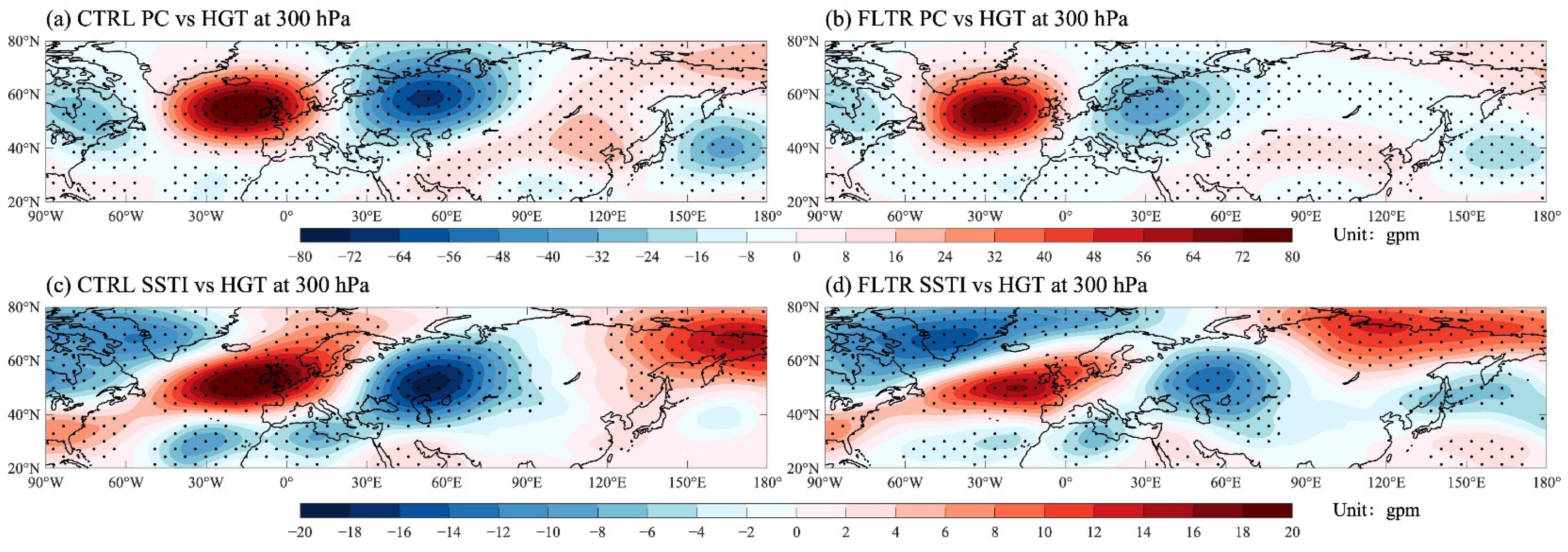
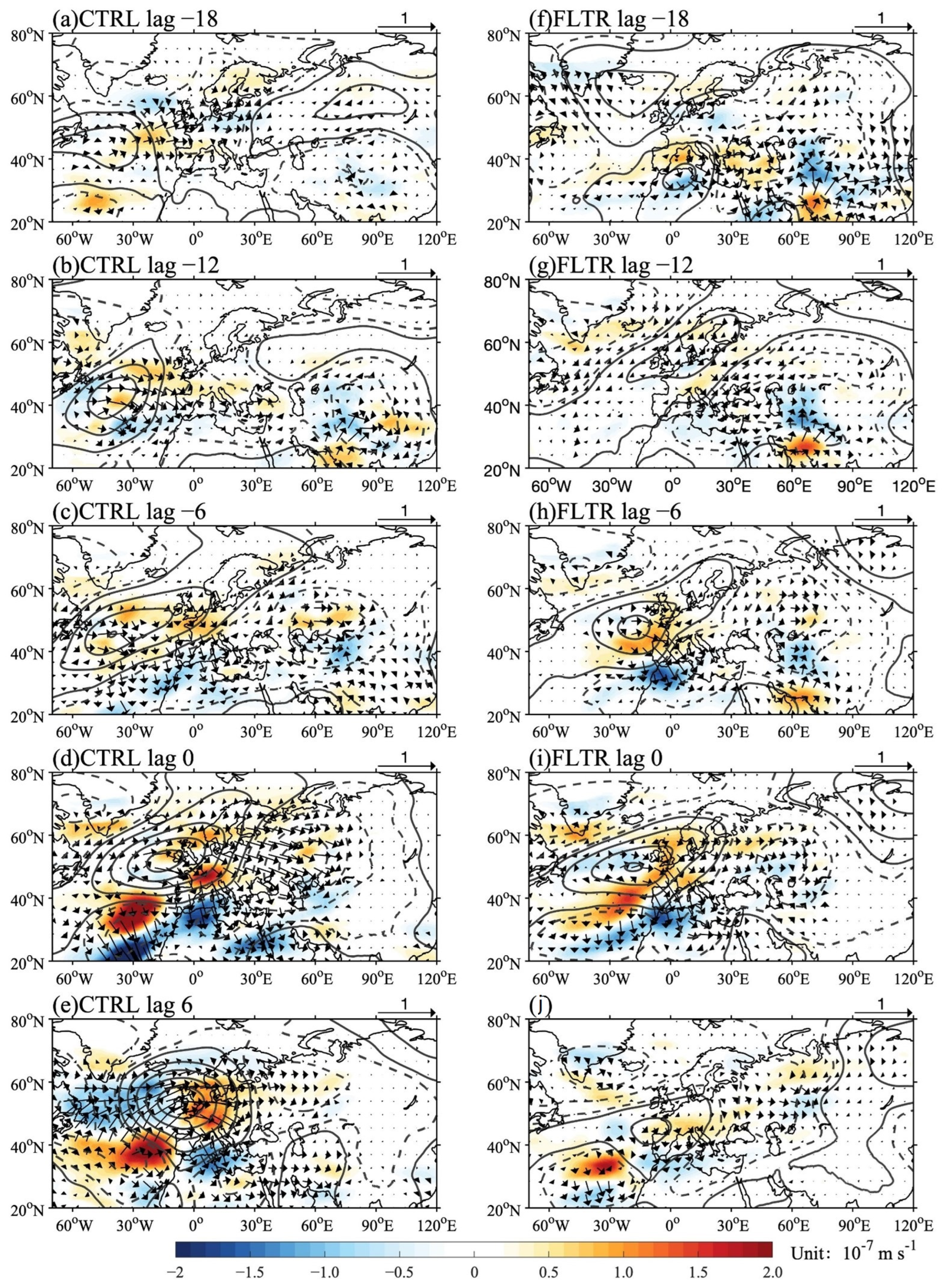
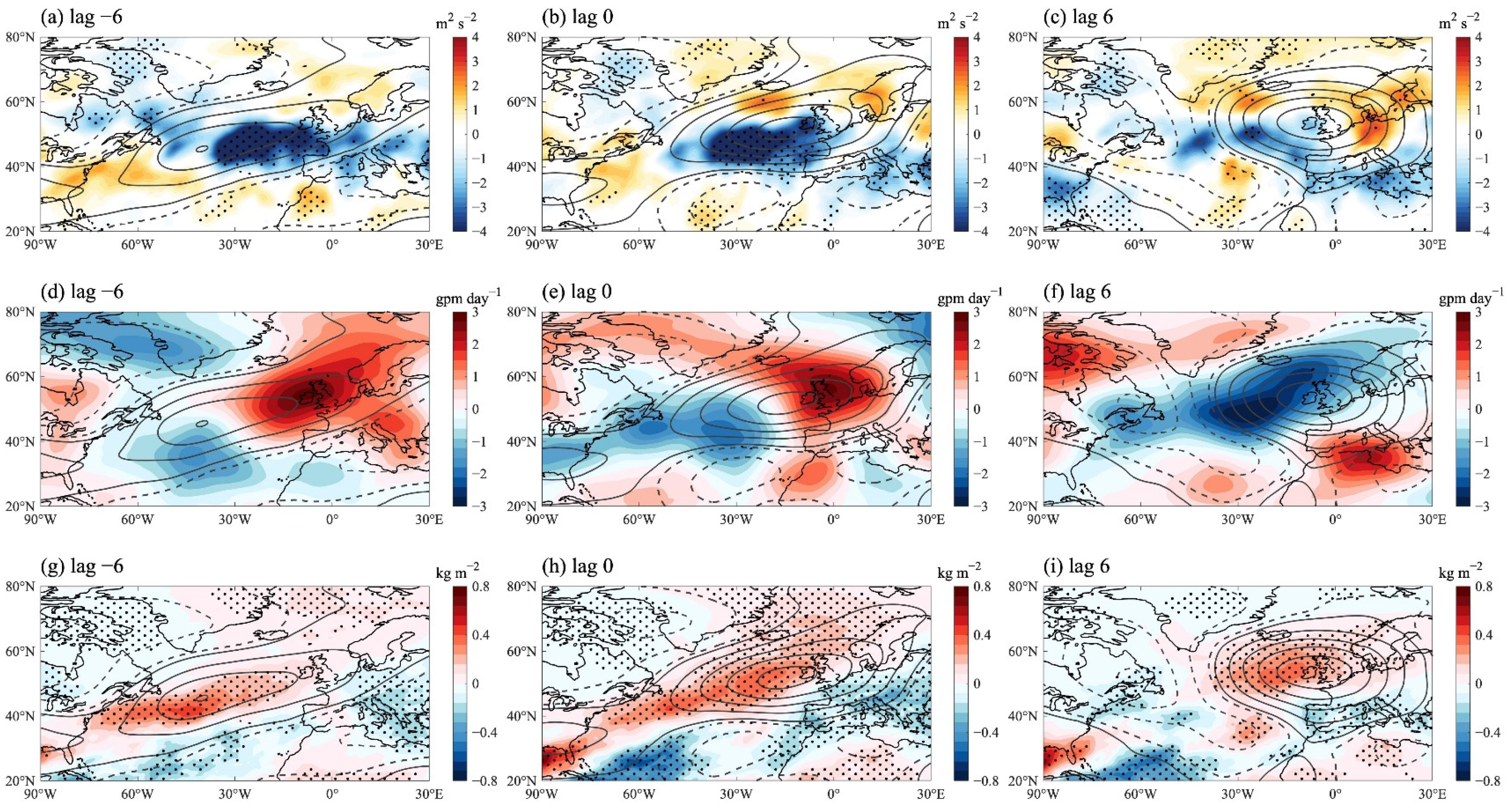
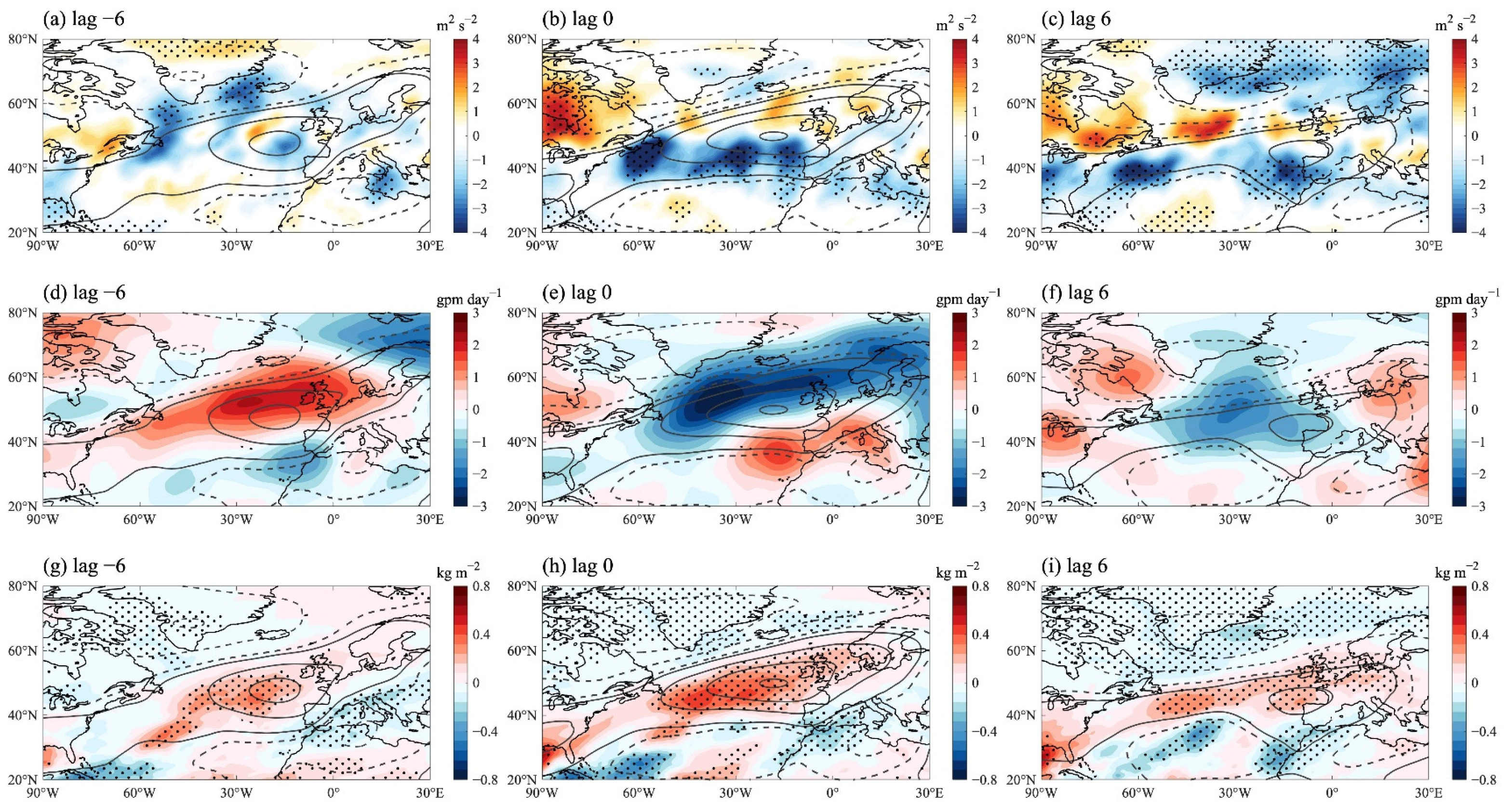
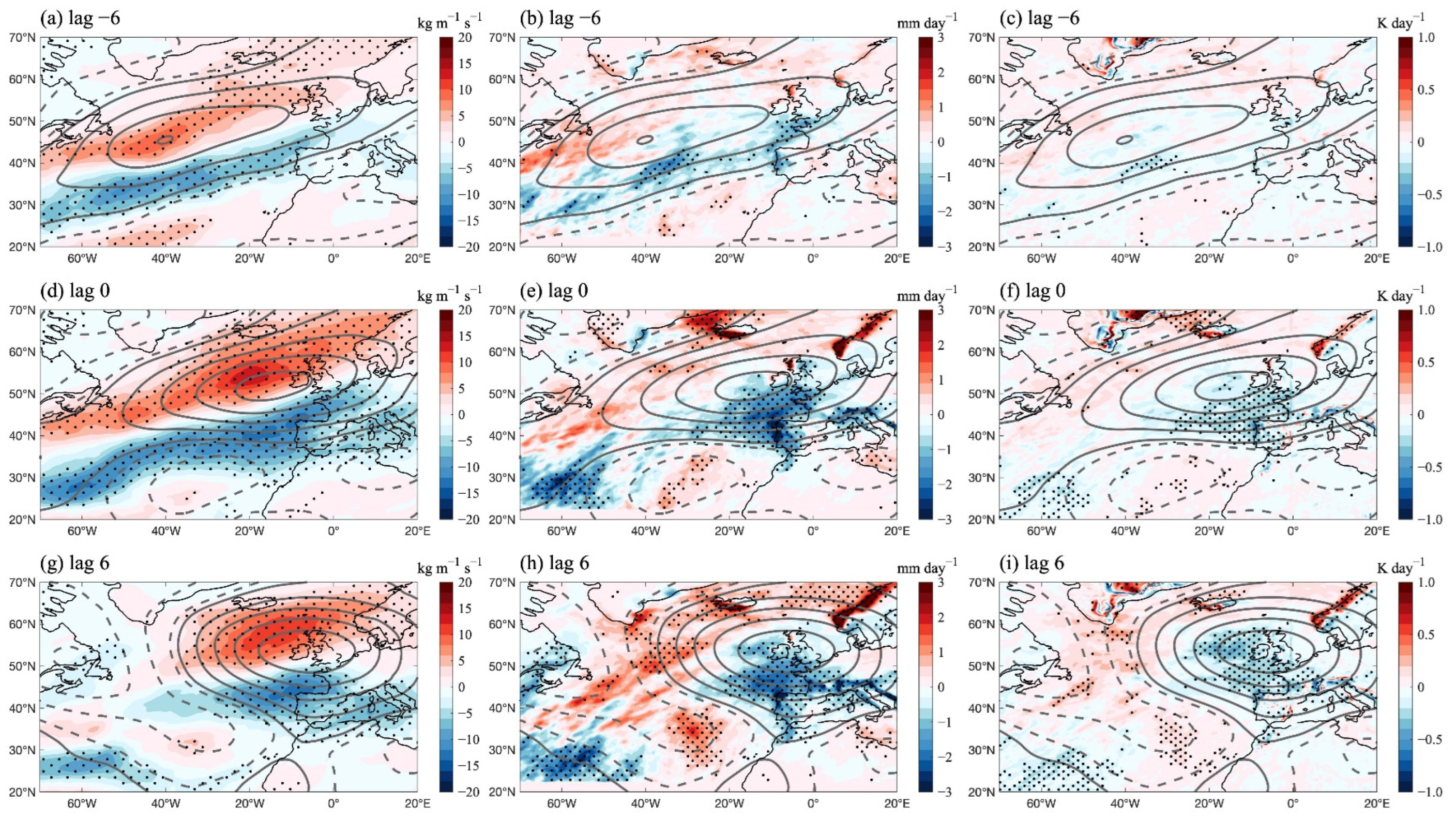


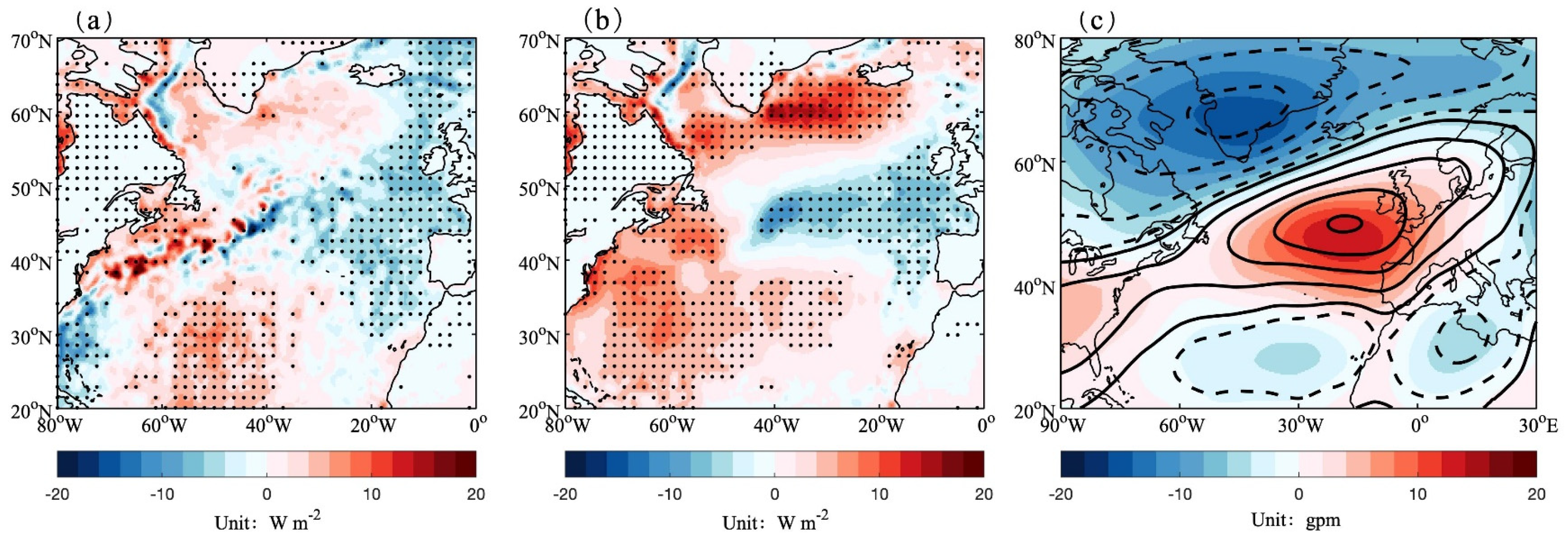
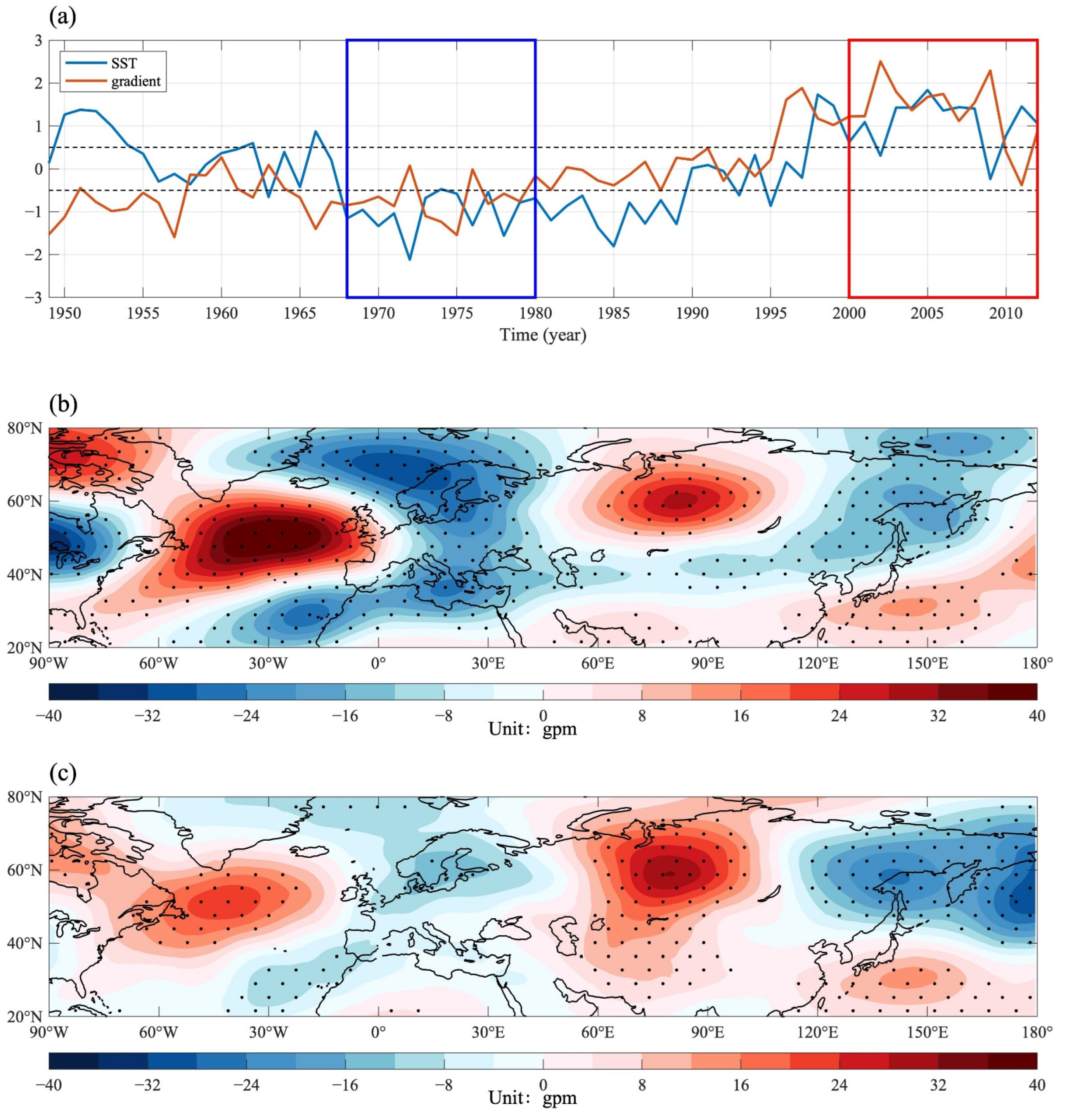
Disclaimer/Publisher’s Note: The statements, opinions and data contained in all publications are solely those of the individual author(s) and contributor(s) and not of MDPI and/or the editor(s). MDPI and/or the editor(s) disclaim responsibility for any injury to people or property resulting from any ideas, methods, instructions or products referred to in the content. |
© 2023 by the authors. Licensee MDPI, Basel, Switzerland. This article is an open access article distributed under the terms and conditions of the Creative Commons Attribution (CC BY) license (https://creativecommons.org/licenses/by/4.0/).
Share and Cite
Xie, X.; Jia, Y.; Han, Z. The Gulf Stream Front Amplifies Large-Scale SST Feedback to the Atmosphere in North Atlantic Winter. Atmosphere 2023, 14, 1758. https://doi.org/10.3390/atmos14121758
Xie X, Jia Y, Han Z. The Gulf Stream Front Amplifies Large-Scale SST Feedback to the Atmosphere in North Atlantic Winter. Atmosphere. 2023; 14(12):1758. https://doi.org/10.3390/atmos14121758
Chicago/Turabian StyleXie, Xiaomin, Yinglai Jia, and Ziqing Han. 2023. "The Gulf Stream Front Amplifies Large-Scale SST Feedback to the Atmosphere in North Atlantic Winter" Atmosphere 14, no. 12: 1758. https://doi.org/10.3390/atmos14121758




